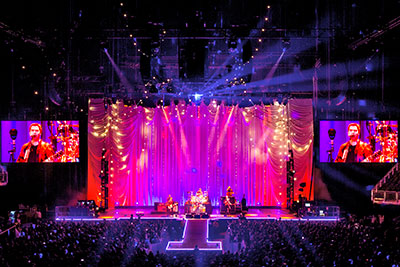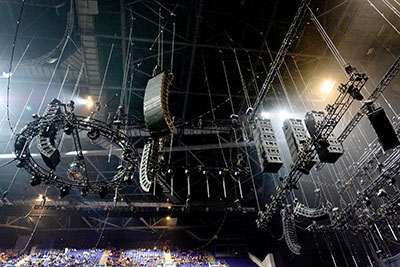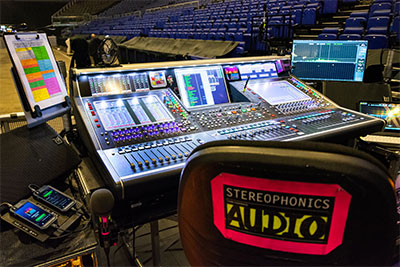After 28 years of touring, the Stereophonics’ continue to improve their stage sound even though their 2020 tour in support of their album Kind is presently on hold on account of the coronavirus shut-down.
 The band had got as far as Cardiff’s Motorpoint Arena in March before shows were cancelled, fielding a new PA arrangement Retaining his preferred Martin Audio MLA loudspeaker array from the last tour, long-term FOH sound engineer Dave Roden had sent his mix to a distributed PA system, running the length of a 60ft thrust from main stage, into the belly of the audience, with a small ‘B’ stage at the end of it.
The band had got as far as Cardiff’s Motorpoint Arena in March before shows were cancelled, fielding a new PA arrangement Retaining his preferred Martin Audio MLA loudspeaker array from the last tour, long-term FOH sound engineer Dave Roden had sent his mix to a distributed PA system, running the length of a 60ft thrust from main stage, into the belly of the audience, with a small ‘B’ stage at the end of it.
By opting to play a third of their set right in the middle of the arena (including a solo Kelly Jones set), it would have left the band at risk of absorbing unwanted sounds off the main PA picked up by the vocal mics, had it been set in a conventional LR configuration. At the same time, performing so far in front of the PA would have required EQ changes that would have been impractical.
It fell to system tech Nick Boulton, who was making his debut on MLA, to come up with a viable solution. He explained, ‘We did some modelling with the aim of getting as much even coverage throughout the arena while keeping the weird noises off the stage. With the end of the thrust 60ft into the room it was well within the coverage area of MLA so we simply moved the hangs downstage.’
He was replacing the band’s usual system tech Toby Donovan, who assumed crew chief duties for this tour. However, Boulton had worked previously with Roden on last year’s Tim Minchin tour, using another of Martin Audio’s optimised PAs. This time around, production was running Dante to the stage and sending AES3 audio to the hangs, with Martin Audio UNet back-up, which he said also proved straightforward. Monitor engineer, Sam Cunningham was using a DiGiCo SD7 on stage while Roden himself was on an SD5 at FOH.
 The tech crew’s solution had been to replace the conventional main stage LR hangs with two side hangs further downstage, comprising respectively two drops of 16 MLA Compact as conventional out fill. Meanwhile, a further eight MLA Compact for in fill were mounted on trusses set near the beginning of the thrust, and angled down.
The tech crew’s solution had been to replace the conventional main stage LR hangs with two side hangs further downstage, comprising respectively two drops of 16 MLA Compact as conventional out fill. Meanwhile, a further eight MLA Compact for in fill were mounted on trusses set near the beginning of the thrust, and angled down.
Boulton says that this operating mode satisfied the set list, which loosely comprised one third rock and roll, one third mellow, and one third on the tiny stage, where a drum kit was waiting.
In this location, three hangs of ten MLA (and two MLD Downfills) – situated in the centre and 90° upstage – formed a concentric arc at the end of the thrust. Three hangs of six MLX subwoofers were set behind that in end fire configuration. This design, Boulton sensed, would reduce the sound bleed at the back of the stage, and help ease the room reflections.
He also says that, in view of the stipulation to minimise sound escape at the main stage, they made heavy use of the Hard Avoid setting in Martin Audio’s Display optimisation software, not only creating rejection at the back of the stage but also the hard surfaces at the rear of the arena that would cause slapback. ‘In fact we worked Hard Avoid to within an inch of its life.’
 Boulton admits to being ‘pleasantly surprised’ by the response of MLA on his first outing with the system. ‘It was a bit of a learning curve, as it required a different way of thinking, but Display is a very flexible tool.
Boulton admits to being ‘pleasantly surprised’ by the response of MLA on his first outing with the system. ‘It was a bit of a learning curve, as it required a different way of thinking, but Display is a very flexible tool.
‘I was impressed by both the coverage pattern and the power, which was excellent. Martin Audio does things in an interesting and fascinating way, we’ve had a better result than we would with a normal LR hang.’
He also notes the speed of getting the system up in the air and to de-rig: ‘Considering I had to take all the room measurements from scratch, and we have had to put hangs in different positions, it has been much quicker and easier than I had expected.’
At the new P&J Live Arena in Aberdeen it had taken just 25 minutes to build the plot: ‘We used around five miles of cabling in total, half a mile to get the main hangs alone,’ he says. Once again MLA showed its advantages. ‘With another manufacturer’s box it would have required a lot more cable and the weight loading would have been considerably larger, which would have been a problem at Bournemouth ICC, which is weight-load restricted.’
‘The band are constantly attempting to improve the experience for their audience, and this was again demonstrated absolutely on this tour,’ adds Capital Sound Account Manager, Martin Connolly.
More: https://martin-audio.com